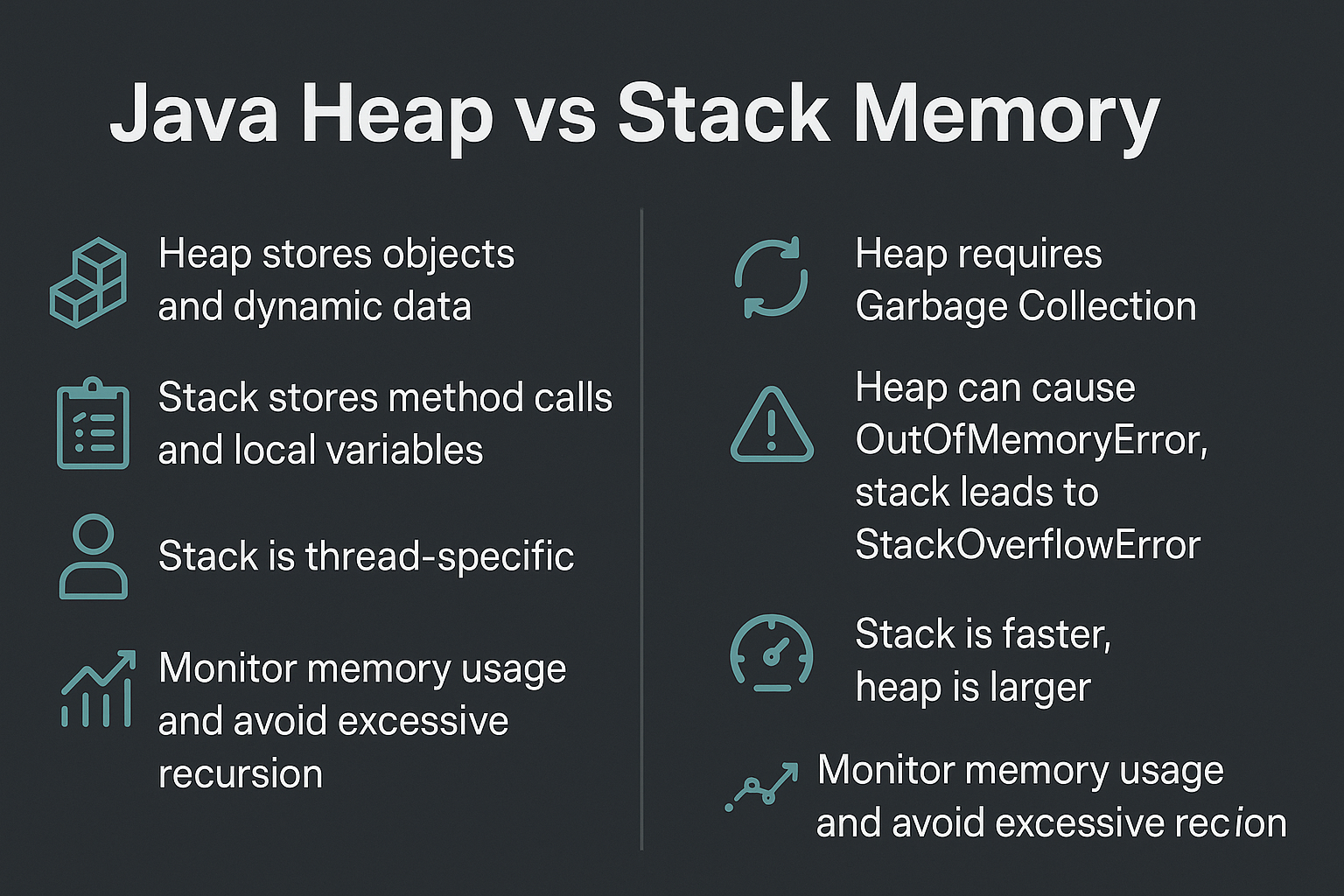Introduction
Memory management is one of the most critical aspects of Java programming. Understanding heap and stack memory helps you write efficient, bug-free, and optimized code.
Why It Matters
- Prevents memory leaks and
StackOverflowError. - Helps optimize performance for large-scale applications.
- Aids in debugging
OutOfMemoryErrorand improving code design.
When to Use
You don’t "choose" heap or stack directly; the JVM manages it. However, knowing what goes where allows you to design better memory-efficient applications.
Core Concepts
Java allocates memory in two major areas:
- Heap Memory – For objects and dynamic data.
- Stack Memory – For method execution and local variables.
What is Heap Memory?
- Shared across all threads.
- Stores objects, instance variables, and arrays.
- Managed by Garbage Collector.
- Size controlled via
-Xmsand-Xmx.
What is Stack Memory?
- Separate for each thread.
- Stores method frames, local variables, references.
- Follows LIFO (Last In, First Out).
- Automatically freed when a method ends.
Variables, Objects, and Method Calls
Stack
public void demo() {
int x = 10; // Primitive stored in stack
MyClass obj = new MyClass(); // Reference stored in stack
}
xlives in the stack frame.objreference is in the stack, but the actual object is in the heap.
Heap
class MyClass {
int value = 42; // Instance variable stored in heap
}
- Instance variables and object data are stored in heap.
Comparison Table
| Aspect | Heap Memory | Stack Memory |
|---|---|---|
| Purpose | Stores objects and dynamic data | Stores method calls and local variables |
| Access | Global, shared across threads | Thread-specific |
| Size | Larger, configurable | Smaller, fixed |
| Management | Garbage Collector | Managed automatically by method calls |
| Error | OutOfMemoryError: Heap Space | StackOverflowError |
| Speed | Slower | Faster due to LIFO |
Real-World Analogy
- Heap is like a warehouse storing goods (objects) accessible by everyone.
- Stack is like a worker’s table—temporary workspace for active tasks (method calls).
Real-World Use Cases
- Large collections, caches → Stored in heap.
- Recursive function calls → Stack frames are created per call.
- Thread-specific data → Stack is isolated per thread.
Common Mistakes & Anti-Patterns
- Excessive recursion:
- Leads to
StackOverflowError.
- Leads to
- Holding unnecessary object references:
- Causes heap memory leaks.
- Confusing primitive and object storage:
- Primitives in stack, objects in heap (except when wrapped in objects).
Performance & Memory Implications
- Stack is faster due to simple LIFO structure.
- Heap requires GC, making it slower but suitable for long-lived objects.
- Mismanaging references leads to high GC overhead.
Tuning Tips
- Use appropriate data structures to limit heap usage.
- Avoid deep recursion—use iteration.
- Profile with JVisualVM, JConsole.
Best Practices
- Keep methods small to reduce stack usage.
- Release references when no longer needed.
- Use
finalfor constants to avoid extra heap allocation. - Monitor memory allocation during load testing.
Java Version Relevance
| Java Version | Change |
|---|---|
| Java 8 | Introduced Metaspace replacing PermGen |
| Java 11+ | Improved GC for heap management |
| Java 17 | Better stack trace optimization |
Code Example: Stack vs Heap
public class MemoryDemo {
static class MyClass {
int data = 100;
}
public static void main(String[] args) {
int a = 10; // Stored in stack
MyClass obj = new MyClass();// obj reference in stack, object in heap
methodCall();
}
public static void methodCall() {
int b = 20; // New stack frame created
}
}
Conclusion & Key Takeaways
- Stack and heap serve different purposes in JVM memory management.
- Stack is for method calls and local variables; heap is for objects and dynamic data.
- Efficient code comes from understanding what goes where and avoiding leaks or overflows.
FAQ
-
Are objects always stored in heap in Java?
Yes, all objects are allocated on the heap. -
Can primitives be stored in heap?
Only if wrapped in an object (e.g.,Integer). -
Is stack memory shared between threads?
No, each thread has its own stack. -
What causes
StackOverflowError?
Deep or infinite recursion. -
What causes
OutOfMemoryErrorin heap?
Creating too many long-lived objects without freeing references. -
Is heap faster than stack?
No, stack is faster due to simple LIFO allocation. -
Can I increase stack size in Java?
Yes, using-XssJVM option. -
Does GC clean stack memory?
No, stack frames are freed automatically after method execution. -
How to monitor heap and stack usage?
Use JVisualVM, JConsole, or Java Flight Recorder. -
What’s the ideal heap/stack ratio?
Depends on the app; monitor and tune based on profiling.
